
With summer temperatures baking much of the US, Texas’s notoriously ailing power grid is set to be put under intense strain once again. Blackouts and power failures are on the cards for many – but previous years have shown some cashing in on the sweltering weather.
Faced with sky-high demand last summer, the Electric Reliability Council of Texas (ERCOT) took extreme measures to curtail the state’s power usage.
Along with issuing eight calls for voluntary energy conservation, the company looked towards Bitcoin mining, the energy-hungry process of using computational power to solve complex mathematical problems to validate transactions on the Bitcoin network and earn newly created bitcoins.
In August 2023, ERCOT reportedly paid a single company $31.7 million in energy credits to reduce its Bitcoin mining operations. The company in question is Riot Platforms, owners of North America’s largest Bitcoin mine in Rockdale with a total power capacity of 700 MW.
“August [2023] was a landmark month for Riot in showcasing the benefits of our unique power strategy,” Jason Les, CEO of Riot, said in a statement (that’s since been removed from their website).
“Riot achieved a new monthly record for Power and Demand Response Credits, totaling $31.7 million in August, which surpassed the total amount of all Credits received in 2022. Based on the average Bitcoin price in August, Power and Demand Response credits received equated to approximately 1,136 Bitcoin,” Les explained.
Later that year, a bill was introduced to restrict the amount of compensation cryptocurrency miners could receive in the form of credits, but it ultimately failed to advance past committees in the House.
It’s unclear whether Texas will dish out similar credits to Bitcoin miners this summer, although the state’s power grid is in store for further trouble. The latest report from ERCOT predicts a 16 percent chance of an electric grid emergency and a 12 percent chance of rolling blackouts in August 2024 between 8 and 9 pm.
Texas is the only state in the continental US with its own electric grid. This has certain advantages, such as dodging federal regulations, but it limits Texas’s ability to import electricity from other states during times of need and emergency.
In recent years, the situation has become even more severe for the Lone Star State due to the boom in computer data centers and artificial intelligence (AI), which sap a gigantic amount of energy. Studies suggest that AI could account for 0.5 percent of global energy consumption by 2027, about the same amount as the Netherlands.
Surging energy demand for AI and crypto will be a problem for many parts of the world, not least Texas, which hopes to pose itself as a hub of tech infrastructure. Whether their electricity grid can keep up remains to be seen.
“ERCOT CEO Pablo Vegas and others gave shocking testimony today in the Senate Committee on Business & Commerce that within only six years (that’s only three legislative sessions), our power grid needs will grow from about 85,000 to 150,000 megawatts,” Dan Patrick, Lieutenant Governor of Texas, posted on X earlier this month.
“Later testimony said the growth is due to the increases in population, normal business growth, and Artificial Intelligence (AI). However, crypto miners and data centers will be responsible for over 50 percent of the added growth. We need to take a close look at those two industries. They produce very few jobs compared to the incredible demands they place on our grid. Crypto mining may actually make more money selling electricity back to the grid than from their crypto mining operations,” he added.
“Texans will ultimately pay the price.”
Source Link: When A Heatwave Struck, Texas Paid A Bitcoin Miner $31.7 Million To Chill Out